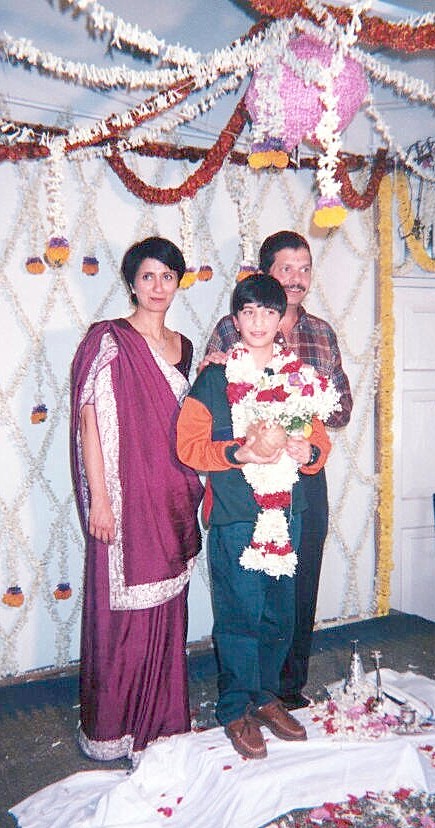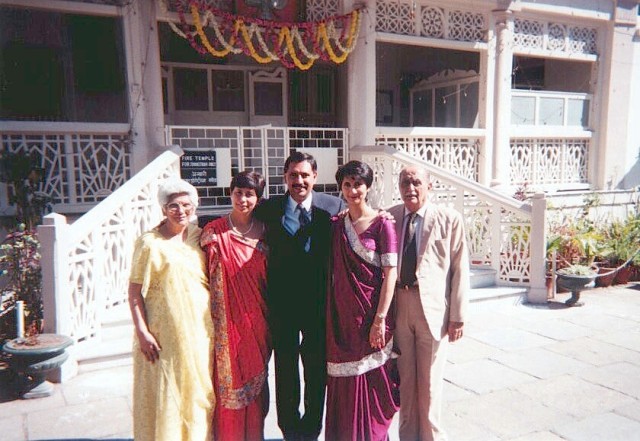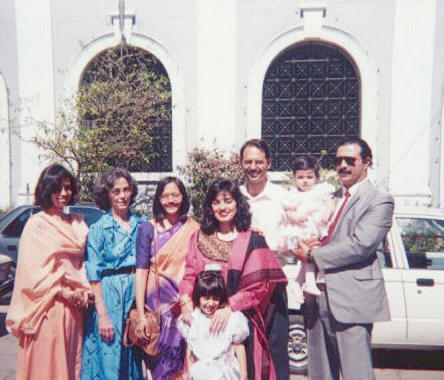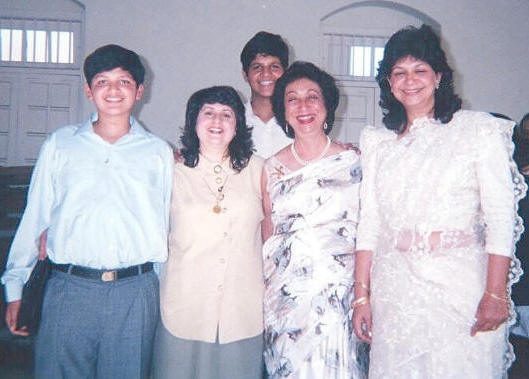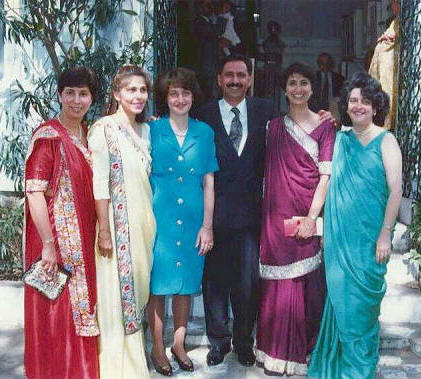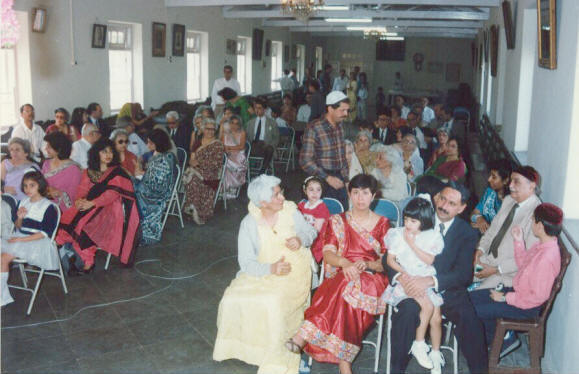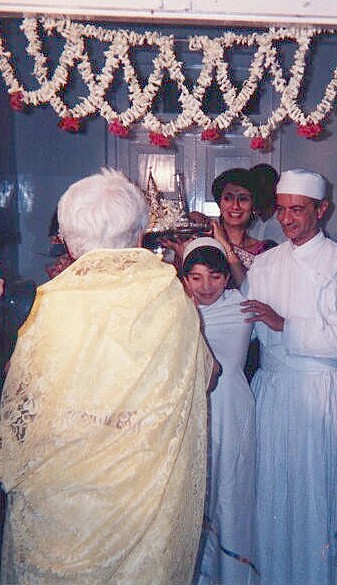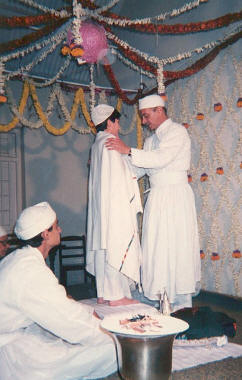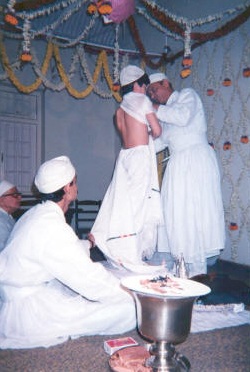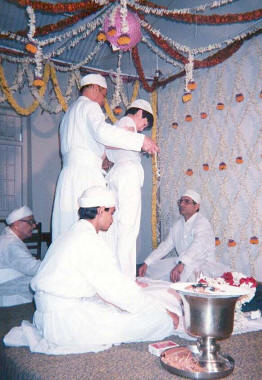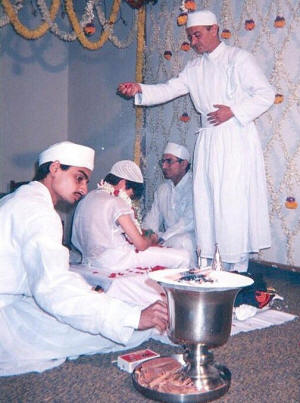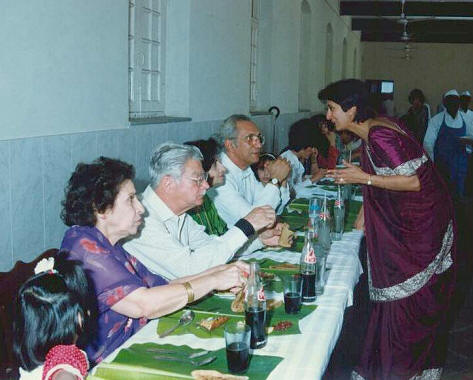
| NAVJOTE Overview
:
Navjote is the Indian-Zoroastrian word for the ceremony. Navjote means new (nav) life (jote). Some say that 'jote' comes from the Avestan word zaotar, meaning one who offers prayers. Sudreh-Pooshi is the Iranian-Zoroastrian word for the ceremony. It means putting on the sudreh or white vest which Zoroastrians wear.
On this page we will call the person being initiated into the faith - the initiate.
The ceremony is held at any place the organizers choose. In the navjote ceremony illustrated here with photographs, the ceremony and following celebrations were held at an Agiary, a Zoroastrian place of worship, in Pune, India, in 1995.
The Family :
Navjote - The initiate and his parents
The
Gathering / Anjuman:
This writer's immediate family in front of the agiari
This writer's cousins and their families
This writer's cousin and her family
The
writer's sisters and their friends
The Gara Sari :
Family and friends await the start of the ceremony :
Family and friends await the start of the public ceremony while the initiate takes a ritual bath Preparing
to Witness the Navjote Ceremony :
Kusti
Prayers :
The practice of memorizing prayers extends from the laity to the priesthood, with the priests memorizing greater sections of the Avesta. This practice is what has preserved the scriptures even when the scriptures were destroyed by antagonists to the faith.
Nahan & Nirangdin - Physical and Spiritual Cleansing :
The start of the Nahan, the ritual cleansing bath Before the navjote ceremony, the initiate undertakes a ritual bath called the nahan, in a bathroom within walking distance of the area where the ceremony will take place. During this time, friends and family seat themselves and await the arrival of the initiate.
In addition to cleaning the body, the nahan includes a spiritual purification called the nirangdin that enables the initiate to enter the faith in a state of spiritual purity. Here, in preparation for the bath, the initiate under the guidance of the officiating priest, recites a prayer and chews a pomegranate leaf (also see baresman).
The initiate then either takes a small sip or symbolically places her or his lips to a small metal container containing nirang (consecrated white bull's urine called taro or gomez when not consecrated). The taro is ritually consecrated to nirang in advance and is believed to have cleansing properties (also see Darmesteter 5.5). The priest will have added to the nirang, a pinch of the bhasam or the consecrated ash from a fire at the fire-temple. The nirang (taro) ritual is part of an ancient practice when taro was used externally and internally as a disinfectant before the advent of modern anti-bacterial agents. While strange today, thousands of years ago, the practice saved lives. When nirang-taro is not available, pomegranate juice can be used as a substitute.
While the bath symbolizes external physical cleansing, the nirangdin represents internal spiritual cleansing. Put in another way, through the nahan and nirangdin rituals, the initiate symbolically prepares herself or himself to partake in the navjote ceremony with clean hands, and a clean heart as well. The symbolism also reminds the initiate that good health is needed to undertake the rigours and responsibilities of life. In the photograph to the left, the priest can be seen giving the initiate a small container. In all likelihood, this container contained taro.
Also in the photograph, note the white, powdered chalk design, called chuna or rangoli, outside the threshold of the bathroom as well as the string of flowers (often tuberoses) on the upper frame of the door called a toran (for more on torans see the page on marriage customs). This practice is both decorative and thought to be auspicious.
The priest stands outside the door while the initiate bathes behind closed doors. After the bath, the initiate puts on a loose fitting white trouser somewhat like a pyjama, a shawl wrapped over the shoulders, back and chest, and a prayer cap. Zoroastrians cover theirs heads while praying.
Ceremonial Walk and Achu Michu :
The walk to the ceremonial area starts
Initiate's mother and aunt carry the sace
Achu Michu: the initiate's grandmother circles an egg around his head
Achu Michu: the initiate's grandmother circles an egg around his head The female members of the family headed by the eldest woman, in this case the initiate's grandmother, play a significant role in accompanying the initiate from the bathroom to the ceremony hall. They carry with them a tray called a sace or ses containing symbolic utensils, a coconut, flowers or a garland, sugar, rice and a set of new clothes, Including a new sudrah and kusti that the initiate will wear after the ceremony.
The belief is that this is a particularly vulnerable time for the initiate as the temptations of evil assail the new initiate in order to introduce doubt and turn the initiate away from the chosen path. Therefore, once the group arrives at the initiation area, the eldest woman, here the initiate's grandmother, exorcises any lurking evil, and prepares the initiate to begin the initiation process, cloaked as it were, with an aura of protection.
During the ritual called achu michu a raw egg is circled around the initiate's head seven times to absorb and ward off evil. Alternatively, rather than circling the egg over the head, the elder can walk around the initiate seven times before smashing the egg on the ground beside the initiate's feet destroying any exorcised evil or the evil that may have been cast of the initiate. The process can be repeated with a water, rice, betel-nut, dates (placed in the tray or held in the hand) and finally a coconut which is also smashed on the ground. Each presumably has a special quality to absorb or ward off evil.
The ritual has no support or justification in Zoroastrianism. It is nevertheless an interesting tradition that adds to the various rituals of the ceremony. The symbolism, is that Zoroastrians are ever vigilant against evil and seek to walk the path of Asha or goodness.
Age of Reason and Responsibility :
At birth, an individual is born into the care of her or his parents and remains their ward until the coming of age. After a navjote, the person is born again into a new life, this time as a responsible person, accountable in this life and the after life for every thought, word and deed. The concept of being born again is an Aryan concept shared with Hinduism where it is called dvijas - twice born (also see our page on Aryan Prehistory - Jamshidi era), and where the initiation or thread ceremony is called upanayana meaning bringing within. Perhaps we can take this to mean that the responsibility for a person's thoughts, words and deeds now resides within that person - within their soul.
During the navjote ceremony, the initiate makes a pledge to abide by the tenants of the faith, a covenant that a Zoroastrian will renew every time she or he recites the Kusti prayers. The initiate should therefore have the capacity to enter into this pledge, to maintain the pledge, and to be responsible and accountable for every thought, word and deed. In Mithraic terms (Mithra is the angel and guardian of contracts and promises), the pledge is a binding contract containing covenants.
At some time after the Arab invasion of Iran and by the time of the writings of the Rivayat (15th to 17th century CE orthodox Iranian answers to questions from the Parsees of India) of Kaus Kamdin (p. 29-30 of manuscript MU 1), the age for the initiation ceremony was lowered and a child could be initiated after the age of seven. Nowadays, for children born to Zoroastrian parents, the navjote ceremony takes place between the ages of seven and twelve. Perhaps initiation at a young age is for reasons of modesty since the sudrah is worn over a bear chest during navjote ceremonies in India (however, the sudrah can be placed over, say, a blouse). However, one wonders whether a child understands the significance of a covenant and whether a person and her or his soul can be considered responsible for decisions made at the age of seven. It would be interesting to know how Zarathushtra initiated the "first hearers and teachers" of the faith listed in the Farvardin Yasht, a chapter within the Zoroastrian scriptures that memorializes Zoroastrians of old.
Navjote Ceremony : Setting :
The Patet: The initiate seeks repentance The traditional ceremony is conducted with priests and the initiate sitting on the floor or on a raised platform. Where priests are not available, the ceremony is conducted by an elder or someone familiar with the rites. The officiating priest sits directly opposite (facing) the initiate. The initiate and sometimes the officiating priest are flanked by assistants.
One of the assistants maintains the fire called the Atash Dadgah. The initiate sits on a low stool, called a patlo, covered with a white sheet. Most Zoroastrian ceremonies are conducted on the floor covered with a white sheet called a sofreh. The practice reminds Zoroastrians to be humble, to be grounded and to stay connected with the earth and nature.
The sace or ses, that in our photographic tour was carried by the mother and aunt, is placed beside the initiate. The sace contains new clothes as well as a sudrah and kusti with which the initiate will be invested.
When sitting opposite one another, the initiate sits facing the sun. During the investiture, the priest will stand behind the initiate and both will face the source of light.
The area is decorated with strings of flowers.
Patet - Repentance :
This part of the ceremony is preformed sitting down, with the initiate and head priest facing one another. The officiating priest and any assistants begin the patet prayers. The initiate joins the prayers if she or he knows the prayers or can follow along. If not, the initiate is expected to silently repeat the Ahunavar (Yatha Ahu Variyo).
At the conclusion of the patet, the initiate and officiating priest rise to stand facing one-another marking the start of the investiture ceremony and the navjote proper. Once standing, together they begin to recite the kusti prayers, prayers for untying and retying the kusti.
Investiture :
The Navjote starts
The Navjote: Putting on the Sudrah Sudreh-Pooshi in Persian
The Navjote: Tying the Kusti Sudrah/Sudre and Kusti/Kushti :
The sudrah/sudre/sudreh and kusti/kushti are articles of faith, worn as undergarments from the navjote ceremony onwards.
The sudrah or sudreh or sudre is a white muslin/cambric vest. One interpretation of the word is sud-rah, meaning the right path in Persian. It has a small pocket at the V of the neckline, a pocket (with a slit facing the chest) for the symbolic collection of a person's good deeds. The pocket is called a giriban, the keeper of the pledge, or kissai karfa, the pocket for good deeds. Before making a moral and ethical judgment on the actions of others, a person is asked to look into her or his own repository of deeds and gauge whether they have the moral standing with which to make such a judgement. The fabric of the sudreh and the charge to keep it clean reminds one to be humble and righteous.
The kusti or kushti is a hollow cord made from seventy two threads of lamb's wool. It is wrapped three times around the waist, over the sudrah. Different meanings are derived from the name ranging from it being an ancient Aryan identifier to a destroyer of evil. The significance of wrapping the kusti three times around the waist is to wrap oneself in the pledge to abide by good thoughts, good words and good deeds. The kusti is knotted twice as a symbol of making a binding commitment to the creed (below).
Fravarane - Pledge of Faith :
The pledge of faith made by the initiate at the navjote ceremony and daily thereafter, is called the Fravarane. The Fravarane contains the creed of the faith: to commit to a life based on good thoughts, good words and good deeds. The following lines are taken from the closing lines of the Fravarane as stated in Yasna 12.
Tandorosti - Blessing :
This stage starts with the priest placing a tila or kunkun (a red powder paste that adheres to the forehead when dry, symbolizing a third, spiritual eye. This is a custom borrowed from the Hindus), a garland around the initiates neck, a coconut, a bouquet of flowers, and betel-nut leaves in the initiates hands. As the priest recites the blessings, he sprinkles the initiate with rice and flower petals, figuratively showering him with good fortune.
Priest showering the initiate with flower petals during the tandorosti
The initiate's mother congratulates him after the tandorosti The initiate has now been initiated into the Zoroastrian faith according to its rites and customs.
Celebration
& Festivities :
When the congratulations and the giving of gifts have finished, the gathering retire to share a meal together.
In India, the custom is, or was, to use banana leaves as disposable plates.
For a person who has just entered the age of reason, and for whom the navjote is also a coming of age celebration, the person is from this day onwards, responsible and accountable for every thought, word and deed.
Sharing a meal together after the navjo Source :
http://www.heritageinstitute.com/ |
|||||||
